| Massage Therapists: A Quick Look |
| Median Salary |
$35,970 per annum |
| Entry-level education |
Certificate/Diploma |
| On-the-job training |
No |
| Primary employers |
Spas |
| Number of positions (U.S.) |
132,800 |
| Job Growth (2012-2022) |
23% (Faster than the national average) |
| New positions (2012-2022) |
+30,000 |
Massage therapists apply touch therapies to the muscles and tissues of the body in ways that promote healing and relaxation. This discipline comprises dozens of unique specialty techniques, such as deep tissue massage or neuromuscular therapy. Read more.
How much do massage therapists make? According to official government data from the Bureau of Labor Statistics, message therapists earn an average of $35,970 per year as of 2012. Read more.
Most massage therapists must complete a state-approved course of vocational training. Program graduates then apply for state licensure, usually by passing an approved exam. Read more.
The job outlook for licensed massage therapists is quite bright. The federal government estimates massage therapy will grow much faster than the average of all American occupations through 2022. Read more.
Massage Therapist Salary
The median hourly wage for massage therapists as of May 2012 is $17.29 per hour or $35,970 a year according to the U.S. Bureau of Labor Statistics (BLS). The highest massage therapy salary earnings may exceed $33 an hour or $70,140 a year. The lowest 10% earners make less than $8.86 per hour or $18,420 annually. In general, the highest-paid therapists work in healthcare settings, including nursing care facilities and physician offices. Geographically, the northeastern and northwestern regions of the U.S. have many of the best-compensated positions in the country—notably, those that pay more than $40,000 a year.
How To Become A Massage Therapist
Becoming massage therapist is relatively easy. The main requirement is to get licensed with the intended state-of-practice. State licensure usually requires a minimum number of hours spent in an approved vocational training program, as well as a passing score on a qualifying exam. Massage therapists can work as independent professionals in private practice or under the aegis of an established enterprise. Many fresh graduates initially choose the latter option as it provides a chance to learn the ropes and develop a clientele without having to simultaneously manage a business. How Long Does It Take To Become A Massage Therapist? The length of a typical massage therapy program should include at least the minimum number of instructional hours required by the state or municipality for licensure. This could be anywhere between 300 to 1,000 clock-hours of classroom or workshop instruction. The most rudimentary vocational courses may last just a few weeks and the most rigorous, 1-2 years.
Educational Requirements
Massage therapists do need some education, but a postsecondary non-degree award or training certificate is sufficient. Nevertheless, the most common single level of educational attainment is the baccalaureate; about 1 in 5 massage therapists have attained a bachelor's degree. Students often begin building their repertoire of skills and techniques with an internship during their formal training. While massage therapy is a very practice-oriented discipline, classroom instruction is also important and required by most states. Licensing bodies expect a minimum number of classroom and/or internship hours not only in massage therapy techniques and theory, but also anatomy, physiology, kinesiology, pathology, hydrotherapy, and basic health and hygiene—including CPR.
Certification
National certification is optional for massage therapists, although many professionals find it enhances their employability. The primary certifying body for massage therapists is the National Certification Board for Therapeutic Massage & Bodywork, or NCBTMB, established about 20 years ago. NCBTMB maintains standards of practice, specifies ethical commitments, and issues professional credentials to “Board Certified Massage Therapists” who pass its Board Certification Exam. The comprehensive exam tests applicants' knowledge of multiple modalities. To become a Board Certified practitioner, students need to first complete 750 hours of coursework, and then accrue 250 hours of documented work experience post-graduation. Graduates must earn these hours within the first six months of finishing school to sit for the NCBTMB examination. They will also have to pass a national background check.
Licensing
Most states—all but 7—regulate massage therapists, and that typically means completing an approved course of training and passing an exam to earn state licensure. Regulatory states may also require continuing education. The number of classroom and/or internship hours required of massage therapy students is growing in some places. Many states now have instructional minimums of 500 hours or more. These hours must be earned at an accredited institution. 'Accredited,' in this case, usually refers to state board approval. Note that some bodyworkers are additionally regulated municipally and must adhere to town ordinances. It's important to check with all possible jurisdictional authorities prior to enrolling in massage therapy school.
Massage Therapist Job Description
What is a massage therapist?
Every year, millions seek massage therapy services to relieve common physical and psychological issues, from pain and stiffness to stress, anxiety and depression. Massage therapists administer subclinical, touch-based interventions that carry relatively few physical risks. The work is literally hands-on, providing a noninvasive complementary solution to conventional medical treatments. Massage therapy is both an art and a science. The touch therapies of this so called complimentary healthcare industry have lately acquired greater legitimacy. Scientific recognition of its substantive health benefits, from improved immune function to pediatric lung capacity, has been growing. Many massage therapists specialize in techniques such as sports, clinical, hot stone, deep tissue, pre-natal and Swedish massage. In practice, massage therapists may employ multiple specialties in a given job. Popular work settings include salons, boutiques, spas, hotels and cruise ships. The highest-paying ones, however, can be found in the medical sector. The best massage therapists are patient and empathetic, able to respect people's physical boundaries while delivering a relatively intimate physical intervention. There is a strong emphasis in massage on holism as well as emotional wellness; a massage therapist is charged with helping people deeply relax on all levels.
Duties
What do massage therapists and bodyworkers do from day to day?
- Perform therapeutic massages on clients in scheduled sessions
- Discuss clients' condition
- Assess clients' body strength and range of motion
- Design take-home therapy plans
- Schedule appointments and re-book clients
- Keep facilities clean, tidy and inviting
Alternative Job Titles
- Bodyworker
- Masseur/Masseuse
Job Outlook
The demand for massage therapy is growing alongside a wider movement emphasizing the role of complementary and alternative medicine, or CAM, in health and wellness. Research from IBISWorld indicates the CAM sector as a whole has seen steady growth, even through the recession. CAM services like massage therapy tend to be relatively recession-proof because they are cost-effective alternatives to conventional medical interventions. The cost of health insurance and public access to coverage therefore influence the massage therapist's job prospects. The BLS estimates the job pool will grow by 23% between now and the year 2022 as the massage arts gain increasing exposure within populations like workers and seniors. The profession could see more than 30,000 new positions open as a result of this explosion in growth.

 What Does A Massage Therapist Do?
What Does A Massage Therapist Do?
Leave a Reply